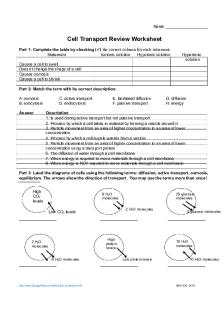02 04 cell transport lab report llllll PDF

| Title | 02 04 cell transport lab report llllll |
|---|---|
| Author | Anonymous User |
| Course | American Humanities |
| Institution | Brigham Young University-Idaho |
| Pages | 3 |
| File Size | 145.5 KB |
| File Type | |
| Total Downloads | 2 |
| Total Views | 189 |
Summary
The medic inside of medicine. I like this desrpeodj. jdhhshsdhfh[ashfhc...
Description
Cell Transport Lab Report Instructions: There are two options for completing the lab. You can either complete the lab at home over the course of three days or watch the teacher-led video and record your observations. Links to the hands-on lab and video observation lab are on the assessment page. Title: Objective(s): Hypothesis: Variables: Independent Variable: Dependent Variable: Controlled Variable: Materials: Raw egg String or thread or yarn Ruler White vinegar Tap water Jar with lid (like a mayonnaise jar or something big enough to put the egg in) Procedure: 1. Before beginning the experiment, record at least two observations of the raw egg in your lab report. 2. Wrap the string around the center of the egg to determine its initial circumference. Measure the string and record the initial circumference in centimeters (cm). 3. Gently wrap the egg in the jar and completely cover the egg with vinegar. Use the lid to seal the jar and note the time. This will be considered the “start time” of the experiment. 4. After approximately 24 hours from the start time, carefully remove the egg from the jar of vinegar. If the shell has completely dissolved, exposing the inner membrane, move on to the next step. If not, return the egg to the vinegar until the shell has completely dissolved. 5. Record at least two observations of the egg. 6. Measure and record the circumference of the egg, being sure to measure it in the same way every time you measure circumference. Unless Otherwise Noted All Content © 2021 Florida Virtual School
7. Pour out the vinegar and rinse the jar. Then fill the jar about half full of tap water. 8. Gently place the egg back into the jar, making sure it is completely covered with water. Use the lid to seal the jar. 9. After a total of 48 hours from the start time, carefully remove the egg from the jar of water. 10. Make two observations of the raw egg, and measure and record the circumference. 11. Gently place the egg back into the jar, making sure it is completely covered with water. Use the lid to seal the jar. 12. After a total of 72 hours from the start time, carefully remove the egg from the jar of water. 13. Make two observations of the raw egg, and measure and record the circumference. Data and Observations: Record your observations from the experiment either the hands-on lab or the teacher led video. Don’t forget to include at least two detailed observations and the measurement of the egg’s circumference in centimeters. Time (hours) 0
Observations 1.
24
2. 1.
48
2. 1.
72
2. 1.
Circumference (cm)
2.
Conclusion: Be sure to answer the following reflection questions as a summary in the conclusion of your lab report: Was your hypothesis correct? Why or why not? How much did the egg change in size? (answer should be in centimeters) Unless Otherwise Noted All Content © 2021 Florida Virtual School
Evaluate the lab and data collected. What type of transport occurred in this lab? Explain your answer, including evidence from your experiment to support your explanation.
Questions: Using what you have learned in the lesson and the experiment, answer the following questions in complete sentences. 1. Consider how lettuce or spinach placed in water becomes firm and crisp. Use what you have learned about cell membranes to explain this observation. Be sure to include homeostasis in your explanation. 2. If you were to continue this experiment by removing the egg from the water and covering it in corn syrup (a hypertonic solution), what do you think would happen? Explain your prediction. (If you choose to test your prediction, be sure to allow at least 24 hours before making your observations. And, of course, handle the egg very carefully!) 3. Equilibrium is when the concentration is the same throughout and entire system. Explain how a cell reaches equilibrium in all three types of solutions (hypertonic, hypotonic and isotonic).
Unless Otherwise Noted All Content © 2021 Florida Virtual School...
Similar Free PDFs

Cell Transport Lab Report
- 2 Pages

Cell Respiration Lab Report
- 4 Pages

4- Cell Transport Review
- 4 Pages

Cell Transport Review Worksheets
- 8 Pages

Cell Transport Activity
- 3 Pages

Ecampa lab report - cell membrane
- 14 Pages

LAB Report BIO411 Cell Biology
- 25 Pages

Separata 04 Unidad 02
- 5 Pages
Popular Institutions
- Tinajero National High School - Annex
- Politeknik Caltex Riau
- Yokohama City University
- SGT University
- University of Al-Qadisiyah
- Divine Word College of Vigan
- Techniek College Rotterdam
- Universidade de Santiago
- Universiti Teknologi MARA Cawangan Johor Kampus Pasir Gudang
- Poltekkes Kemenkes Yogyakarta
- Baguio City National High School
- Colegio san marcos
- preparatoria uno
- Centro de Bachillerato Tecnológico Industrial y de Servicios No. 107
- Dalian Maritime University
- Quang Trung Secondary School
- Colegio Tecnológico en Informática
- Corporación Regional de Educación Superior
- Grupo CEDVA
- Dar Al Uloom University
- Centro de Estudios Preuniversitarios de la Universidad Nacional de Ingeniería
- 上智大学
- Aakash International School, Nuna Majara
- San Felipe Neri Catholic School
- Kang Chiao International School - New Taipei City
- Misamis Occidental National High School
- Institución Educativa Escuela Normal Juan Ladrilleros
- Kolehiyo ng Pantukan
- Batanes State College
- Instituto Continental
- Sekolah Menengah Kejuruan Kesehatan Kaltara (Tarakan)
- Colegio de La Inmaculada Concepcion - Cebu







